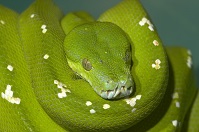Challenges in the development of sperm cryopreservation protocols for snakes
Carly Young A B , Nicole Ravida A and Barbara Durrant
A B , Nicole Ravida A and Barbara Durrant  A
A
A San Diego Zoo Wildlife Alliance, Beckman Center for Conservation Research, 15600 San Pasqual Valley Road, Escondido, CA 92027, USA.
B Corresponding author. Email: cyoung@sdzwa.org
Reproduction, Fertility and Development 33(9) 605-609 https://doi.org/10.1071/RD21038
Submitted: 1 February 2021 Accepted: 6 May 2021 Published: 1 June 2021
Abstract
Snake populations are declining worldwide, but research devoted to the development of sperm cryopreservation techniques for this taxon is very limited. Spermatozoa were collected postmortem from snakes of four squamate families (Elapidae, Colubridae, Viperidae and Pythonidae). Viability assessment was performed before and after cryopreservation. Spermatozoa were extended in TES and Tris (TEST) yolk buffer with 12% dimethylsulfoxide (DMSO) or 12% glycerol and frozen at a rate of 0.3°C min−1. The sperm quality index (SQI), representing three viability parameters (motility, plasma membrane and acrosome integrity), was determined. Despite some species differences, glycerol was a more effective cryoprotectant for Colubridae, whereas DMSO provided greater cryoprotection for spermatozoa of members of the other three families.

Keywords: endangered species, freezing, reptile, semen, squamates.
References
Jaskey, D. G., and Cohen, M. R. (1981). Twenty-hour to ninety-six-hour storage of human spermatozoa in TEST-Yolk buffer. Fertil. Steril. 35, 205–208.| Twenty-hour to ninety-six-hour storage of human spermatozoa in TEST-Yolk buffer.Crossref | GoogleScholarGoogle Scholar | 7202744PubMed |
Luiselli, L. (2006). Testing hypotheses on the ecological patterns of rarity using a novel model of study: snake communities worldwide. Web Ecol. 6, 44–58.
| Testing hypotheses on the ecological patterns of rarity using a novel model of study: snake communities worldwide.Crossref | GoogleScholarGoogle Scholar |
Mattson, K., DeVries, A., Krebs, J., and Loskutoff, N. (2009). Cryopreservation of corn snake, Elaphe gutatta, semen. Reprod. Fertil. Dev. 21, 179–180.
| Cryopreservation of corn snake, Elaphe gutatta, semen.Crossref | GoogleScholarGoogle Scholar |
Mengden, G. A., Platz, C. C., Hubbard, R., and Quinn, H. (1980). Semen collection, freezing and artificial insemination in snakes. In ‘Contributions to Herpetology. No. 1. Reproductive Biology and Diseases of Captive Reptiles’. (Eds J. B. Murphy and J. T. Collins.) pp. 71–78 (Society for the Study of Reptiles, St Louis University: St Louis.)
Pope, C., Zhang, Y., and Dresser, B. (1991). A simple staining method for evaluating acrosomal status of cat spermatozoa. J. Zoo Wildl. Med. 22, 87–95.
Williams, W., and Pollak, O. (1950). Study of sperm vitality with the aid of eosin–nigrosin stain. Fertil. Steril. 1, 178–181.
| Study of sperm vitality with the aid of eosin–nigrosin stain.Crossref | GoogleScholarGoogle Scholar |
Young, C., Ravida, N., Curtis, M., Mazzotti, F., and Durrant, B. (2017). Development of a sperm cryopreservation protocol for the Argentine black and white tegu (Tupinambis merianae). Theriogenology 87, 55–63.
| Development of a sperm cryopreservation protocol for the Argentine black and white tegu (Tupinambis merianae).Crossref | GoogleScholarGoogle Scholar | 27639519PubMed |
Young, C., Ravida, N., Rochford, M., and Durrant, B. (2018). Sperm cryopreservation in the Burmese python (Python bivittatus) as a model for endangered snakes. Reprod. Fertil. Dev. 30, 185.
| Sperm cryopreservation in the Burmese python (Python bivittatus) as a model for endangered snakes.Crossref | GoogleScholarGoogle Scholar |
Young, C., Ravida, N., and Durrant, B. (2019). Challenges in the development of semen cryopreservation protocols for snakes. Cryobiology 91, 190.
| Challenges in the development of semen cryopreservation protocols for snakes.Crossref | GoogleScholarGoogle Scholar |
Zacariotti, R., Guimaraes, M., Jensen, T., and Durrant, B. (2012). Cryopreservation of snake semen: are we frozen in time? Reprod. Fertil. Dev. 24, 171.
| Cryopreservation of snake semen: are we frozen in time?Crossref | GoogleScholarGoogle Scholar |


